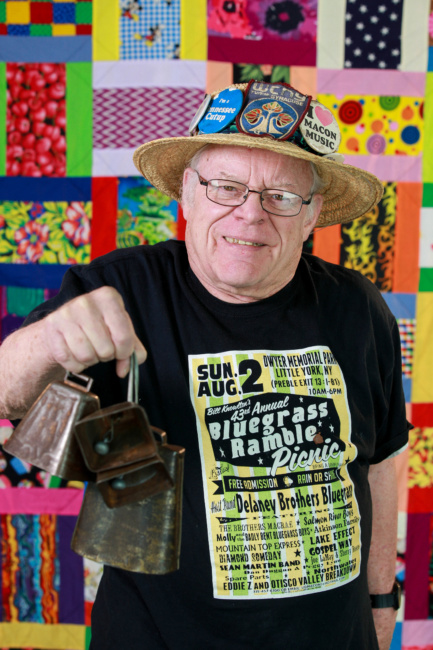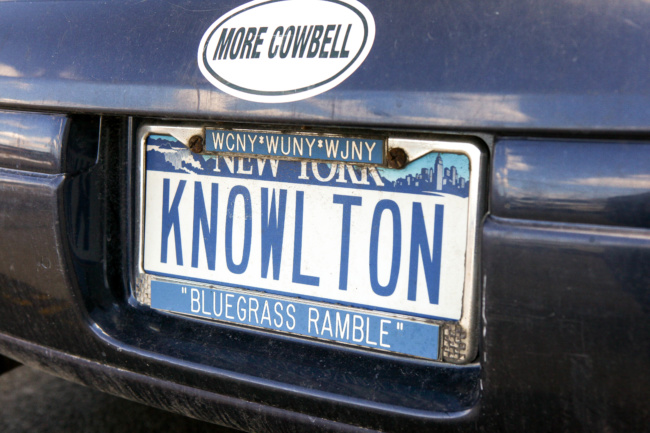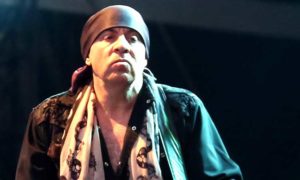In 1973 Richard Nixon was president; Spiro Agnew, his vice president, resigned under duress; U.S. troops were withdrawn from Vietnam; the Watergate hearings began; Roe v. Wade went to the Supreme Court; hip-hop and hand-held cell phones first appeared. In Syracuse Lee Alexander was the mayor, Jim Boeheim was an assistant basketball coach at Syracuse University, gas was 40 cents a gallon, and Bluegrass Ramble, Bill Knowlton’s radio show, debuted on WCNY-FM 91.3.

Bluegrass broadcaster Bill Knowlton holds up his well-known cow bells for a photo. Michael Davis/Syracuse New Times)
Although much has changed since then, Knowlton’s broadcast — currently airing Sundays from 9 p.m. to midnight — endures, now in its 46th year. As notable as that may seem, Knowlton’s experience as a broadcaster of bluegrass music began in 1959 when he was a student at Fordham University. He launched New York City’s first all-bluegrass radio show, Bluegrass Ramble, on WFUV-FM, the university station. Later the program moved to WBZY in Torrington, Conn.
Originally from New York City, Knowlton has established himself over the years as an internationally recognized figure in the world of both bluegrass and the earlier “old-time country music” genre, as a broadcaster, emcee at bluegrass events, authority and historian.
This recognition includes awards from the International Bluegrass Music Association (Broadcaster of the Year, 1997; Distinguished Achievement Award, 2011); the Syracuse Area Music Awards (Sammys) (Hall of Fame, 2006); the Syracuse Press Club (Lifetime Achievement Award, 1994); the Cultural Resources Council (Service to the Arts Award, 1983); and the Jesse Messick Award, for emceeing the Uncle Dave Macon Days in Murfreesboro, Tenn., in 1992.
A retired Air Force lieutenant colonel, Knowlton, 79, is also an authority on the life and career of Uncle Dave Macon, a star of the Grand Ole Opry and an early old-time country music icon, and has written liner notes for a collection of Macon’s music. Knowlton is also a familiar presence at bluegrass festivals, having hosted hundreds of events throughout New York and the Northeast.
His own event, the Bluegrass Ramble Picnic, is the oldest bluegrass festival in the northeastern United States, staged locally every August since 1973. The next picnic is slated for Aug. 5 in Dwyer Memorial Park, beside Little York Lake in Preble.
Additionally, Knowlton has produced and emceed 52 half-hour Bluegrass Ramble TV shows for WCNY and the Eastern Educational Television Network, two 60-minute documentaries on the Bluegrass Ramble Picnic, and the annual Barn Dance radio broadcast with six local bands and a live audience. Knowlton has also emceed the IBMA Fanfest in Louisville and Nashville and participated in the efforts to save the Ryman Auditorium, Nashville’s venerated country music venue, in the mid-1970s.
Knowlton recently sat down with the Syracuse New Times at the studios of WCNY for an interview.
You became interested in country music in the 1950s, didn’t you?
This was pre-Bill Haley and the Comets. Joni James, Jo Stafford, Frankie Laine, they covered songs from mainstream country artists such as Hank Williams and Carl Smith. I had no idea about country or hillbilly music until I heard a disc jockey play the original version of “Jambalaya” by a hillbilly singer named Hank Williams. I was astounded by that sound; I had never heard it before. Then I discovered Don Larkin, a disc jockey in Newark, N.J., who played hillbilly music three hours a day.
At the same time you must have encountered Bill Haley and the other rockers. Did you ever feel out of step?
Of course. I was totally out of step. Out of 6,000 students at my high school I could identify on one hand students who liked hillbilly music. We found a takeout with a jukebox with two hillbilly songs and we played those.
Tell me about your Bluegrass Ramble radio program at Fordham University.
I started it as a senior. It was on for a half-hour once a week. When I left it went with me to Connecticut. I got a job at WBZY as a typical disc jockey. On my own, without pay, I did another hour called Bluegrass Ramble on Sunday afternoons.
Bluegrass Ramble now features old-time country music and bluegrass. What’s the difference?
Old-time country music is to bluegrass what ragtime is to Dixieland. The string band music was the basic old-time fiddle tunes, ballads and novelties with guitar, bass and the clawhammer (strum with a pick) banjo. Tremendous stuff. The string band recordings from the 1920s are off the top, with people like Gid Tanner and the Skillet Lickers, Uncle Dave Macon, Charlie Poole, the North Carolina Ramblers.
Bill Monroe and the Bluegrass Boys were a wonderful old-time string band, with the fiddle, guitar, mandolin, bass. Bill was looking for a new sound out of old-time music. Then he was introduced backstage at the Grand Ole Opry (the Ryman Auditorium in Nashville) to a banjo picker named Earl Scruggs. Scruggs basically auditioned for him there. This was 1945. Lester Flatt was already with Bill Monroe. Flatt said, “I think you ought to hire him, Bill.” This turned his band into an entirely different sound of string band music, with the three-finger style of banjo Scruggs popularized.
Bill had an ego a mile long. Other people started copying Monroe’s style with this new three-finger banjo style, which infuriated Monroe. People started saying, “You sound like Bill Monroe’s band. You pick bluegrass.” So the name came from Monroe’s band, not the state (Kentucky).
Bluegrass is essentially Appalachian music, arising out of hardship, isn’t it?
Bluegrass is Appalachian music. Radio took it out of Appalachia to every place in the United States: WWVA in Wheeling, W.V., WSM in Nashville, WCKY in Cincinnati. These stations blasted it into New England, where they heard the Osborne Brothers, Jimmy Martin and the Sunny Mountain Boys.
A lot of these people were Appalachian. They had teeth. There was hardship and suffering, such as losing the farm. These are themes going back to the 1930s and the Depression. They did go through the same things we go through in our lives, but we don’t write songs about it. This is what I love about bluegrass: There are dozens of topics. We’re not just zeroed in on love and sex; there’s a whole lifestyle to be sung about in bluegrass music.
There are distinctive vocal and instrumental styles in bluegrass, aren’t there?
There are many different styles of people (singers) in bluegrass, not just the high lonesome sound, which was really Bill Monroe and Ralph Stanley. Baritone is accepted now. Stanley’s singing of “O Death” in (the 2000 movie) O Brother, Where Art Thou, you talk about the high lonesome sound. You freeze when you hear that.
Is there an orthodoxy in bluegrass? Did Bill Monroe set the rules?
Oh yeah. What is bluegrass anyway? A battle between the traditionalists and the progressives. You’ve got people who want to electrify and add drums. This has been going on since the 1960s and 1970s with newgrass. In bluegrass the mandolin is supposed to be the percussion. I don’t play Elvis’ version of (Bill Monroe’s) “Blue Moon of Kentucky” because it’s electric.
I don’t mean that everybody has to play “Foggy Mountain Breakdown.” There are still new songs being written in the original styles. But I notice that the ones that push the envelope over the table don’t last that long. I don’t want to be a moldy fig, but people want to hear bluegrass, not country pop.
Gospel music is about one-quarter to one-third of bluegrass. It’s optimistic. It’s still the five basic instruments (guitar, bass, fiddle, mandolin, banjo). And the dobro, Flatt and Scruggs introduced that instrument. It’s a resonator guitar. Dobro is a registered trademark, made by Gibson, I think.
You started Bluegrass Ramble at WCNY in 1973. How did that come about?
In 1972 I was stationed in the NORAD region (Syracuse) as an Air Force public affairs officer. I started volunteering at WCNY. It was an eclectic station at that time: jazz, classical, talk. I got a 15-minute segment on the nostalgia show All Our Yesterdays called “The Dusty Record Show” and played old 78 rpm records.
There was a variety show called Today’s Music Tonight. The program manager wanted to fire the disc jockey. I was convenient to him so he put me on playing bluegrass from 10 p.m. to 1 a.m. I did it live the first couple of years. It went to 9 p.m. to midnight when WCNY went all-classical.

Bumper thumper: Bill Knowlton has his own custom license plate with his name and show. (Michael Davis/Syracuse New Times)
Those recordings were vinyl LPs at the time, weren’t they?
Oh yes. I played my own collection and promotional copies from record companies. When bluegrass was dropped by the major labels, including Decca, Columbia and MGM, the bluegrass people formed their own labels and did very well with them. I still have maybe 1,000 LPs; they’re all over the house.
At the same time (1973) you started the Bluegrass Ramble Picnic. How did that happen?
When I started the show I began noticing that there were bluegrassers in the area and at Syracuse University that didn’t know that the others existed. It was like coming out of a closet. My show became a sort of bulletin board. I thought, “We ought to have a picnic and get together.” One night three guys in VFW hats came in and offered their property if they could get the revenue from the beer and food they sell. That was the first one, at the VFW in Hannibal.
Over the years it got much too big. It was turning into a Woodstock, and 90 percent of the people were not there for the music. I said, “The hell with this!” Then I restarted it at the fairgrounds in Seneca Falls. Then we went into a paid mode, hired bands and charged admission. We had co-sponsors but no upfront money. Then it was a three-day affair.
After the last sponsor pulled out we went back to the way it was in 1973: one day, nobody gets paid, and that’s what I’ve done ever since, down at Dwyer Memorial Park in Little York. But my expenses are getting more and more: the tent, the sound system, and now I have to pay copyright fees and an insurance bill. It’s getting to be another damn job.
How has your show changed over the last 46 years?
Not much. I have a formula as to a fast one, a slow one, an instrumental, an old-time song. I pre-plan. I put it all together here at WCNY on Thursday afternoon. It’s just like a live radio show; I do the whole three hours. I get promotional CDs and CDs from players at bluegrass festivals. I’m like Jackson Pollock: I just start throwing this one in this half-hour and this one in that half-hour.
Why don’t you segue songs on your program?
I’m the old-fashioned big mouth. Between songs I have information about who’s on the session and about what’s going on in the area regarding festivals and concerts. Some people say I talk too much, others say I’m the show, but I’ve been doing it the same way for 45 years. Tradition is very important. People love ritual.
Who are some of the original bluegrass musicians that you have met?
Bill Monroe, Lester Flatt, Earl Scruggs, Don Reno, Red Smiley, Mac Wiseman, Bill Clifton, the Osborne Brothers, Jimmy Martin, Ralph Stanley. I’m turning 80 in October. I was in the right place at the right time. I wish I’d been born earlier so I could have met Uncle Dave Macon.
Speaking of Macon, does he know that you stole his email address ([email protected] or [email protected])?
His family knows it. I’m not sure they were happy about it at first, but we’re very close.
What’s so interesting about Macon to you?
The showmanship, his exuberance. He was a 19th-century man in the 20th century. He was the biggest star of the Grand Ole Opry until Roy Acuff. A total character. He made 155 recordings but we only have a 90-second clip of him in the 1940 movie Grand Ole Opry.
You’re widely regarded as an authority on bluegrass music. Is there anyone that knows more about bluegrass than Bill Knowlton?
Oh, my god, yes. There are those known for their articles for the bluegrass bible, Bluegrass Unlimited magazine. The most authoritative person on old-time music was the late Charles Wolfe.
You have been recognized by the International Bluegrass Music Association (IBMA) as a broadcaster and with an Outstanding Achievement Award. The name Bill Knowlton is on their website along with Bill Monroe, Flatt and Scruggs and others. How does that make you feel?
That really floored me. It’s one unit away from the Bluegrass Hall of Fame. They make it a point to give that award to not-so-famous people.
What does it take to be a bluegrass musician?
You need a total respect for the basics of bluegrass music. And you have to have a little bit of initiative and creativity to bring your own persona to what it is. You see that in jam sessions.
Did you ever play an instrument?
I used to strum the guitar. I like to be like Ed Sullivan, the guy in the middle who knows a lot about the acts. My role as an emcee is how I participate. I have a hell of a lot of fun with that.
I’m known for having the world’s worst collection of pants. For many years I had a quilter who made them, such as plaids that would stand up by themselves if I took the batteries out. I will continue to dazzle in my sartorial style.
Did you ever fantasize about being a bluegrass musician?
I have fantasized about being at the Ryman Auditorium. I would love to go there and create a 1939 Grand Ole Opry. There are plenty of young people that can play old-time music. I’m also sorry that I never took up the clawhammer banjo.
What is the place of bluegrass in today’s culture?
It’s a niche that has survived in spite of the odds. Right now it’s being helped by being streamed on the internet. I’ve told people bluegrass was born in 1945 and it’s been dying ever since. It’s an anachronism.
You have been involved with bluegrass music for more than 60 years. How does that sit on you?
I’m delighted. This station (WCNY) has been incredible. I’ve been grandfathered. Bluegrass is foreground music, like classical. Over the years we’ve had a preponderance of great bluegrass musicians here. The No. 1 we’re famous for is Tony Trischka. Our bluegrass associations and festivals are how we preserve bluegrass music. We’re a thorn in the side of mainstream country music. It always amused us that the big-time country artists feel compelled to make a bluegrass album.
What do you see in the future for the Bluegrass Ramble?
It would be a lot of fun to get to 50 (years on the air). I would be 84 then.
[fbcomments url="" width="100%" count="on"]










